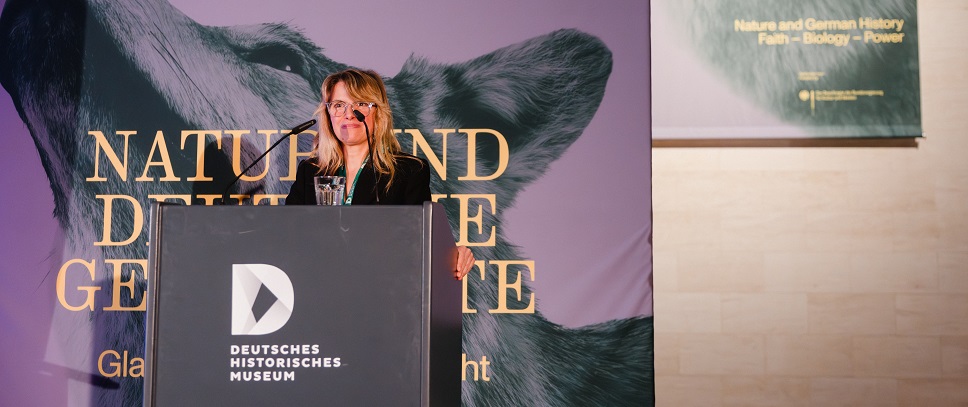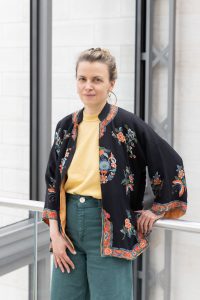
Nature and German History. Faith – Biology – Power
Opening speech of curator Julia Voss
14 November 2025
The exhibition “Nature and German History: Faith, Biology, Power” opened today in the Pei Building of the Deutsches Historisches Museum. During the opening ceremony on 13 November 2025, curator Prof. Dr Julia Voss gave the following speech:
I would like to address three aspects of the exhibition “Nature and German History: Faith, Biology, Power”:
Why do we begin as we do – namely with Hildegard of Bingen in the 12th century?
We begin with Hildegard of Bingen in the 12th century, a period that has been described as the “founding era”: many towns and monasteries were established: expanding, self-contained cultural landscapes. At this time Hildegard founded her monastery on the Rupertsberg near Bingen am Rhein at the age of about 50. In this regard, she is a typical representative of this transformation.
But she is also an exceptional figure: Hildegard, a Benedictine nun, composer and abbess, who reports experiencing visions that she understands as divine messages. She was the first woman in history to receive permission from the Pope in Rome to write these visions down, in Latin, of course. The word “nature” does not play a central role for her, but rather the term “viriditas”, derived from the Latin word for green. She understands this “greening power” as a divine occurrence that permeates all living things. Hildegard deals intensively with creation, animals and plants, and their healing properties. But it is not a one-way street: plants and animals, she believes, can heal humans. Conversely, humans must also serve the “greening power” in order to contribute to the healing of creation. So here we have a very versatile, learned woman of the Middle Ages who asks herself what order creates or disrupts in relation to creation – to us that seemed like an interesting starting point.
“Hildegard of Bingen” is the first case study or historical “window”, the first vignette with which we begin. We bring together a total of almost two dozen such examples or turning points from around 800 years of German history.
These historical windows are arranged in five chronologically consecutive rooms: the Middle Ages, the early modern period, industrialisation, National Socialism, and divided Germany (this is also the order of the accompanying volume, published by Matthes & Seitz).
Why do we end as we end – namely with the environmental policy of the 1970s?
Our exhibition comes to an end around fifty years ago, in the mid-1970s: a new word establishes itself in the German language, “Umweltschutz” (environmental protection). “Umweltschutz” finds its way into the first party platforms and as a department in ministries – I will come back to that later. At the same time, it is an issue that was then increasingly being demanded by large protest movements. Our example is the anti-nuclear movement in Wyhl am Kaiserstuhl, a middle-class movement consisting of winegrowing families, pastors, craftsmen and academics, including many women.
Wyhl would become important for the founding members of the Green Party. A new era was launched in which “environmental protection” was increasingly seen as an issue for the liberal and left-wing parties. However, there was still a strong conservative current within the movement in Wyhl. As we show in the exhibition, it was Hans-Dietrich Genscher and the FDP who wanted to anchor environmental policy at the federal level. Previously, Willy Brandt, as the SPD’s chancellor candidate, had also advocated for this approach. Marked by “environmental protection”, the 1970s seemed to be a good historical moment to end with for us as a historical museum.
What are the structuring elements of the exhibition?
I have already mentioned the large chronological rooms. We conducted an interview with a historian for each of these rooms. These interviews can be seen in abridged form as videos in the exhibition – found in each room at the bright yellow steles – and are printed in full length in the accompanying volume. It was important to us in this way to be able to reflect the breadth of the historical research we have drawn on.
Each of the individual historical windows we open, the case histories or vignettes, is introduced by an animal or a plant: the dove, for example, leads to Hildegard of Bingen. The wolf depicted on the poster leads to the Thirty Years’ War. Other animals and plants include the potato, the oak, the moss, the peacock, the swamp turtle, the red alder, and the beluga whale. Each of these animals and plants played a special role or had special significance in the historical episode we recount. The animals and plants are marked in a shade of red and accompanied by an introductory text.
|
|
Julia VossProf. Dr. Julia Voss is the curator of the exhibition “Nature and German History” and Research Associate at the Deutsches Historisches Museum. |
